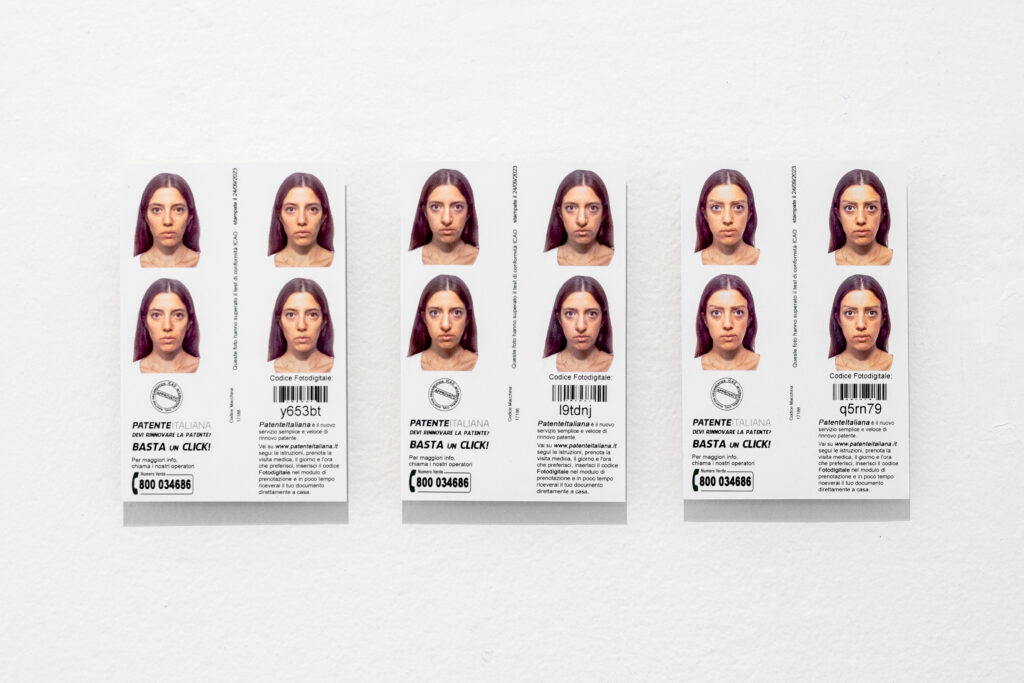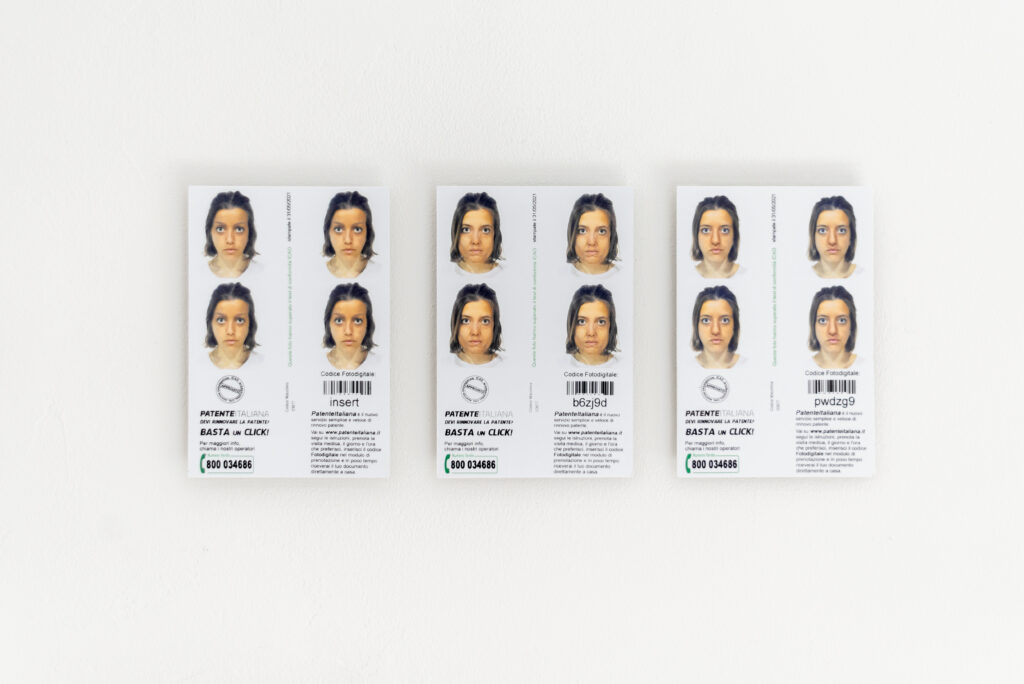On the occasion of Sara’s upcoming solo show at Area Treviglio this October, I decided to visit her studio in Milan. I am a bit early and it’s incredibly hot, so I decide to grab a gelato on the square behind—a pale lemon and hazelnut cone. As I enjoy the treat, its colors bring to mind her silicone prosthesis. I can’t help but wonder if she will greet me with one of those on.
Sara’s work is an investigation of the notions of skin and identity. With a background in sculpture, she lately started to incorporate photography and performance within her pieces, which often appear delicate on the outside—just like my cone’s colors—and multi-layered when one starts diving into them. It’s a process that takes time, both for the artist to produce the works and for the viewer to grasp them.
Once my gelato is over, I ring the bell. She hugs me and I immediately realize she left her silicone prosthesis somewhere else. Her studio is the neatest—although she would claim the opposite. On the right side are two desks, one for thinking, one for making. On the left, a wooden shelf hosts her works: wrapped frames, new ceramic experiments and the hyper-realistic silicone molds of her face. She lets me sit at the desk used for thinking and starts talking about her work in a very self-aware tone, revealing a deep care and understanding of her artistic practice.

We first met at the “ReA! Art Fair” in 2021, where you were exhibiting Autoritratto, a piece that explored the equation face=identity. How has your practice evolved since then?
I’m still delving into this theme. I’m fascinated by how in today’s society our identity is represented by our face, which can serve as our formal signature. Think about the fact that we have portraits on our passports, which we also use to unlock our phones. Some airports have introduced systems where only by recognizing your face, you can pass through security.
Production-wise, working with printing and their support is still relevant for me. Autoritratto was printed on cotton paper, which gave a tactile feeling to the image. I still engage with photography and casting, but I am increasingly incorporating performance elements into my work.
Let’s save the performance for later. How did you start working with casts?
During my BA at the Brera Academy, Milan, I studied sculpture and constantly worked with direct casting. I would extract elements from reality that intrigued me and use pure wax to create thin membranes that would become fragments of a whole picture.
It feels like you have a clear thread running through your practice from the beginning.
Exactly, only retrospectively I realize how everything is connected. I was already interested in the surface of reality, its skin.
What fascinates you about it?
The fact that it directs your focus to the surface, yet beneath lies an entire hidden world.
How did you start using photography?
It was a very unconscious process. During my BA in sculpture, I began photographing with my phone surfaces that intrigued me, without any artistic pretext. I captured images of dry soil, animal skin textures, veins, etc. This was in 2015, so the phone quality was still quite poor. I even opened an Instagram account just to archive them! It was only a few years later, during an examination at school with my teacher Simone Bergantini, that I realized the value of those pictures and how they connected to my use of casts. This led to the creation of a first artist book. I later produced a refined version of it during a workshop with Luca Panaro, titled “hoc videos”.

She shows me the first book she made, a unique copy with a beautiful olive-green cover. It’s a thick collection of images intertwining cropped details of textures, dead animals, plants; everything is very zoomed in and often abstract. I immediately recognize the same method she uses when making molds: starting by taking something from reality and transforming it into something else, always fragmented.
After the book, you kept exploring photography by making incorporarsi, an UV-print of your grandmas’ veins on a Carrara marble slab. To me, it really challenges the perception of what I am looking at.
I’m interested in fully integrating photography with the materials, creating an illusory outcome. Photography and the material become one, absorbing each other.

How did the collaboration with make-up artists start for making the molds for Autoritratto?
I started with the help of a dear friend of mine, Camilla Cavenaghi. We made a cast of my entire torso, and from there, she began producing silicone fragments. It’s a long and slow process, taking time to color them to match my skin. She has been studying my natural skin tones, moles, and veins. As my practice has developed, I now have three additional collaborators who work for me on commission.
In ID, you took a significant step forward. You began wearing silicone prostheses to alter your appearance and took self-portraits in a photobooth, a tool traditionally used to certify our identity through our faces and allocate the instantly generated image to institutional documents.
Exactly. At the moment, I have two molds specifically sculpted to change the shape of my nose slightly—it can be longer or more hunched. I also have a new forehead and cheeks. Let me show you.
She stands up and reaches the shelf. She unwraps a mold from its plastic film and I’m not sure if I’m supposed to look or not. It’s the mold used to cast one of her noses. She displays it open on the shelf but I can’t say a word. She looks at me and opens another one, this time her left eye. There’s something intimate about this moment that bothers me. True reproductions of her facial parts presented to me in a different form. Very disturbing. I take a sip of water.

Mmmh. When I look at them I see relics. I also think about when you’ll be dead and your hyper-realistic pieces will still be here, even worn by someone else.
Yes, we can certainly talk about death now. I’ve delved into a lot of research on the history of photography including post-mortem photography, the practice of taking pictures of the recently deceased. I also read about how the Romans and Greeks used to wear death masks during funeral processions, it was quite shocking to discover. The family had the need of keeping the deceased alive by wearing their death mask.
What inspired you to photograph these silicone molds instead of displaying them as they are?
I’m interested in how sculpture is interpreted and mediated through photography. It introduces a sort of distance, you can never physically engage with the actual object. This tension creates a sense of disturbance that I like.
In this way, you almost create puzzles that subtly make fun of the viewer.
I don’t think it’s about making fun. You know what? Recently, I showed my three IDs in Rome and I went to the opening wearing new silicone molds that altered my nose and chin. Unless you know me, you wouldn’t realize they were fake and that wasn’t my natural physiognomy. There were four versions of myself in that space. I still recall the look a visitor gave me. She was staring at those three passport photos, then back at me, almost obsessively trying to decipher what was happening. At that precise moment, I saw the look of a disturbed person.
So uncanny. Did you talk to her?
Yes, she approached me very confused and I explained the work. I felt like my work was resolved in her disturbed look, because in my practice I ask the viewer to pay attention and explore the details.
Yeah, you seem to enjoy performing and playing with the viewer! That’s why I was thinking about making fun. Everything in your work is very subtle.
I’m not explicitly saying “look at me, give me attention”, it’s more about encouraging people to take their time to explore and create a personal connection. It’s like with the marble slab, I ask you to observe it, don’t I?
Future projects?
I have been trying to analyze and theorize my sculptural approach through direct casting in relation to photography, with the aim of publishing some written material in the future. Now I am preparing for my upcoming show in October at Area Treviglio, where I plan to present a few older pieces alongside new material to showcase the spectrum of my production and research.
What do you know about the contemporary Swedish art scene?
What you publish through SWIT Platform, and I saw some of it when you invited me to the group show at FG2 in Gothenburg last year. But I have to say that my first approach to Swedish art was in 2016 when I discovered Vasli Souza, a gallery that resonated with me and whose work I still follow. They moved from Malmö to Oslo a few years back.

Sara Davide (Milano, 1994) is a Milan-based artist. She holds a BA in Sculpture, an MA in Photography from Cfp Bauer, Milan, and she is enrolled in the MA in Photography at the Brera Academy, Milan. Recent exhibitions include Bar.lina (Roma 2024), MARS Frankfurt (2024), FG2 (Gothenburg 2023), Pavillon am Milchhof (Berlin 2023), Fabbrica del Vapore (Milan 2022).
www.saradavide.com
Interview by Stefano Conti
Images by Sara Davide

